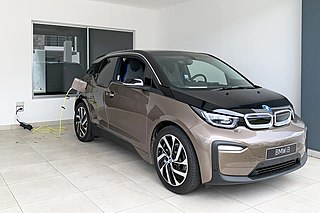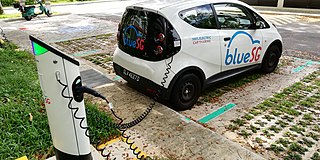
Energy storage is the capture of energy produced at one time for use at a later time to reduce imbalances between energy demand and energy production. A device that stores energy is generally called an accumulator or battery. Energy comes in multiple forms including radiation, chemical, gravitational potential, electrical potential, electricity, elevated temperature, latent heat and kinetic. Energy storage involves converting energy from forms that are difficult to store to more conveniently or economically storable forms.

Renewable energy is energy from renewable natural resources that are replenished on a human timescale. The most widely used renewable energy types are solar energy, wind power, and hydropower. Bioenergy and geothermal power are also significant in some countries. Some also consider nuclear power a renewable power source, although this is controversial. Renewable energy installations can be large or small and are suited for both urban and rural areas. Renewable energy is often deployed together with further electrification. This has several benefits: electricity can move heat and vehicles efficiently and is clean at the point of consumption. Variable renewable energy sources are those that have a fluctuating nature, such as wind power and solar power. In contrast, controllable renewable energy sources include dammed hydroelectricity, bioenergy, or geothermal power.

A rechargeable battery, storage battery, or secondary cell, is a type of electrical battery which can be charged, discharged into a load, and recharged many times, as opposed to a disposable or primary battery, which is supplied fully charged and discarded after use. It is composed of one or more electrochemical cells. The term "accumulator" is used as it accumulates and stores energy through a reversible electrochemical reaction. Rechargeable batteries are produced in many different shapes and sizes, ranging from button cells to megawatt systems connected to stabilize an electrical distribution network. Several different combinations of electrode materials and electrolytes are used, including lead–acid, zinc–air, nickel–cadmium (NiCd), nickel–metal hydride (NiMH), lithium-ion (Li-ion), lithium iron phosphate (LiFePO4), and lithium-ion polymer.

An electric vehicle (EV) is a vehicle whose propulsion is powered fully or mostly by electricity. EVs include road and rail vehicles, electric boats and underwater vessels, electric aircraft and electric spacecraft.
Green computing, green IT, or ICT sustainability, is the study and practice of environmentally sustainable computing or IT.

A zinc–air battery is a metal–air electrochemical cell powered by the oxidation of zinc with oxygen from the air. During discharge, a mass of zinc particles forms a porous anode, which is saturated with an electrolyte. Oxygen from the air reacts at the cathode and forms hydroxyl ions which migrate into the zinc paste and form zincate, releasing electrons to travel to the cathode. The zincate decays into zinc oxide and water returns to the electrolyte. The water and hydroxyl from the anode are recycled at the cathode, so the water is not consumed. The reactions produce a theoretical voltage of 1.65 Volts, but is reduced to 1.35–1.4 V in available cells.

A nickel–zinc battery is a type of rechargeable battery similar to nickel–cadmium batteries, but with a higher voltage of 1.6 V.

A rechargeable alkaline battery, also known as alkaline rechargeable or rechargeable alkaline manganese (RAM), is a type of alkaline battery that is capable of recharging for repeated use. The formats include AAA, AA, C, D, and snap-on 9-volt batteries. Rechargeable alkaline batteries are manufactured fully charged and have the ability to hold their charge for years, longer than nickel-cadmium and nickel-metal hydride batteries, which self-discharge. Rechargeable alkaline batteries can have a high recharging efficiency and have less environmental impact than disposable cells.
A zinc-bromine battery is a rechargeable battery system that uses the reaction between zinc metal and bromine to produce electric current, with an electrolyte composed of an aqueous solution of zinc bromide. Zinc has long been used as the negative electrode of primary cells. It is a widely available, relatively inexpensive metal. It is rather stable in contact with neutral and alkaline aqueous solutions. For this reason, it is used today in zinc–carbon and alkaline primaries.

Clean technology, also called cleantech or climatetech, is any process, product, or service that reduces negative environmental impacts through significant energy efficiency improvements, the sustainable use of resources, or environmental protection activities. Clean technology includes a broad range of technology related to recycling, renewable energy, information technology, green transportation, electric motors, green chemistry, lighting, grey water, and more. Environmental finance is a method by which new clean technology projects can obtain financing through the generation of carbon credits. A project that is developed with concern for climate change mitigation is also known as a carbon project.

Jeffrey Brian Straubel is an American businessman and electrical engineer. He spent 15 years at Tesla, as chief technical officer until moving to an advisory role in July 2019. In 2023, he was elected to the company's board of directors.

Solar power, also known as solar electricity, is the conversion of energy from sunlight into electricity, either directly using photovoltaics (PV) or indirectly using concentrated solar power. Solar panels use the photovoltaic effect to convert light into an electric current. Concentrated solar power systems use lenses or mirrors and solar tracking systems to focus a large area of sunlight to a hot spot, often to drive a steam turbine.
Eco-Cement is a brand-name for a type of cement which incorporates reactive magnesia, another hydraulic cement such as Portland cement, and optionally pozzolans and industrial by-products, to reduce the environmental impact relative to conventional cement. One problem with the commercialization of this cement, other than the conservatism of the building industry, is that the feedstock magnesite is rarely mined.

An electric vehicle battery is a rechargeable battery used to power the electric motors of a battery electric vehicle (BEV) or hybrid electric vehicle (HEV).

An electric battery is a source of electric power consisting of one or more electrochemical cells with external connections for powering electrical devices. When a battery is supplying power, its positive terminal is the cathode and its negative terminal is the anode. The terminal marked negative is the source of electrons. When a battery is connected to an external electric load, those negatively charged electrons flow through the circuit and reach to the positive terminal, thus cause a redox reaction by attracting positively charged ions, cations. Thus converts high-energy reactants to lower-energy products, and the free-energy difference is delivered to the external circuit as electrical energy. Historically the term "battery" specifically referred to a device composed of multiple cells; however, the usage has evolved to include devices composed of a single cell.
Form Energy is an American energy storage company focused on developing a new class of cost-effective, multi-day energy storage systems that will attempt to enable a reliable and fully-renewable electric grid year-round. Form Energy's commercial product is a rechargeable iron-air battery capable of storing electricity for 100 hours at system costs competitive with legacy power plants.
Fluidic Energy is a corporation based in Scottsdale, Arizona that develops metal–air rechargeable batteries. The company sells systems for energy storage applications from rural electrification to critical backup power and has strong ties throughout the US, Latin America, Asia, and Africa. In March 2015 the Company signed a deal with Caterpillar, which included an equity investment in Fluidic Energy as well as a commercial agreement to collaborate in the microgrid and telecommunications markets. Over the following year, the company announced two separate MOUs for some of the largest renewable-energy rural electrification projects of their kind. The Company is dedicating its operations to “paving the path for the smart, sustainable grid of the future.”

Saft is a French company involved in the design, the development and the manufacturing of batteries used in transport, industry and defense. Headquartered in France, it has an international presence.

Contemporary Amperex Technology Co., Limited (CATL) is a Chinese battery manufacturer and technology company founded in 2011 that specializes in the manufacturing of lithium-ion batteries for electric vehicles and energy storage systems, as well as battery management systems (BMS). The company is the biggest EV and energy storage battery manufacturer in the world, with a global market share of around 37% and 40% respectively in 2023. The company is headquartered in the city of Ningde in China's Fujian province.
Korea Zinc Company, Ltd. is a non-ferrous metal smelter headquartered in Seoul, South Korea. It is one of the leading refined zinc-producing companies alongside Nyrstar, Hindustan Zinc, and Boliden. Korea Zinc produces 18 types of valuable metals and chemical products by processing various raw materials from zinc and lead concentrates to low-grade ore and scrap metal.














